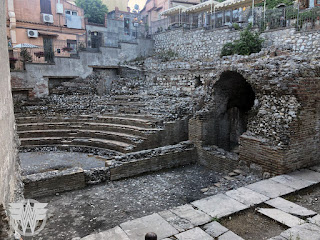 |
| The theatre of Syracuse, overlooking the sea |
Sicilians, we found, do not think of themselves as Italian - at least, not only Italian. Sicilian traditions have been going on since before the Roman empire, when the Greeks were masters of the Mediterranean. And where the Greeks sailed, they built.
Mostly they built temples, but they also built theatres - temples of tragedy dedicated to the Gods.
There are ruins around Sicily of small auditoriums dedicated to performance and public speaking, such as this small one in the city of Noto. But Sicily has two large amphitheatres in the true Greek style.
The city of Taormina near the port of Naxos is famous for its Greek theatre dating back to the 3rd century BC. In Greek times actors performed famous tragedies, and when Sicily fell under the Roman Empire the theatre was partially rebuilt in brick and made into a circus arena.
The largest and most famous theatre is the Theatre of Syracuse, first built in the fifth century BC (or around that time, according to our guide and Wikipedia!), a huge white wonder with a sweeping view of the sea.
Around the theatre, at the top of the seating enclosures looking down into the stage, are inscribed the names of the gods, as well as the Sicilian kings and queens who patronised the performances.
We were fortunate enough to see a gorgeous performance of Euripides' The Trojan Women after our tour.
The Trojan queen Hecuba leads her women in grieving the warriors lost to the Greeks, including her son Hector, and her daughters enslaved or killed as sacrifices.

The Greeks enter the city as the women are mourning, and set it aflame.
It was a beautiful, captivating tragedy, a brief journey backward in time. We were so grateful to enjoy this connection to a people whose legacy has endured thousands of years.









No comments:
Post a Comment
Note: Only a member of this blog may post a comment.